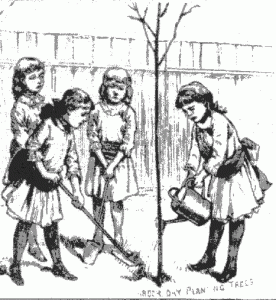Where this RecordClick genealogist grew up, there’s an oak tree in the backyard of the house. It began as an acorn from a tree in my grandmother’s yard. I do believe that tree started out as an acorn from an oak tree that my great-grandfather had planted.
When the ancestors of this genealogist settled in Nebraska, trees were to be cherished. Most of the land was prairie grass and the sod had to be broken for planting. Trees are not to be taken for granted in this state. This is the reason that J. Sterling Morton conceived of the idea of Arbor Day and why Nebraska is the home of this special day.
For a genealogist, his story is a good one about how a family moves, influences the area where they live, and then moves on.
The genealogist will find that the history of the Morton family in America goes back to colonial times. J. Sterling Morton was born in New York in 1832. At an early age, he moved with his family to Detroit, Michigan. It was there that he received the majority of his education. He attended the state university at Ann Arbor and received his degree in 1854 from Union College in Schenectady, New York. Later that year, he married his childhood sweetheart Caroline Joy French and, on the day of their wedding, the couple moved to Nebraska.
When the genealogist explores records, it is important to pay attention to all the activities of the person in your ancestor search. Although Morton was listed as a farmer, he did a lot more. He also served in the territorial legislature and was a newspaper editor in Nebraska City. He was a father, too, and his family grew to include four sons.
Here is the family in the 1870 U.S. Census:
- Morton, JS 38 Farmer NY
- Morton, CA 36 Keep house Maine
- Morton, J 14 At school Michigan
- Morton, P 13 At school Michigan
- Morton, M 11 At school
- Morton, C 5
As the genealogist will see, Morton’s activity in civic affairs meant that he had a high profile in the state. Trees were a passion of his and with his wife Caroline, he planted many varieties around their Nebraska home, known today as Arbor Lodge.
In January of 1872, he introduced a resolution to the Nebraska state Board of Agriculture requesting that a day be set aside in April for the planting of trees. With support from the board members, the resolution was passed and the first Arbor Day was celebrated in April 1872.
About one million trees were planted in Nebraska that year and again in 1873, almost the same number of trees were planted. The state tradition was born.
The genealogist can follow the documentation of the Nebraska development of Arbor day and this can provide historic as well as ancestral insight into the process of the special day’s creation.
As time passed, the Morton sons began to branch out, but in 1880, they were listed together in one more census.
In the 1880 U.S. Census of Otoe County, Nebraska the Morton household consisted of:
- Morton, Sterling 48 Farmer NY VT NY
- Caroline 46 Wife Keep House ME ME ME
- Joy 24 Son Merchant MI NY ME
- Paul 23 Son RR Freight Agt MI NY ME
- Mark 21 Son RR Freight Agt NE NY ME
- Carl 15 Son Student NE NY ME
As the genealogist knows, life has a way of creating stayers and goers. Some family members remain close to their roots. Others move on to other ventures. J. Sterling Morton’s oldest son, Joy, chose to move on. According to Joy’s obituary in the May 10, 1934 edition of the Omaha World-Herald, the genealogist will find that Joy relocated to Chicago in 1879 and entered the salt business with the firm of E.I. Wheeler & Co. In 1885, Joy gained control of the business and the name was changed to Joy Morton & Co. It is now known as the Morton Salt Company. Joy died in the Chicago area in May 1934 and is buried there. The genealogist can see that he never forgot his Nebraska trees and his family’s devotion to Arbor Day. During his lifetime, he honored his father by creating an arboretum in the Chicago area.

In an 1882 illustration, trees are planted for Arbor Day. CREDIT:
Frank Leslie’s Illustrated Newspaper
Back to J. Sterling Morton, Joy’s dad. J. Sterling had continued serving the public and caught the attention of Grover Cleveland. Cleveland tapped Morton to serve as United States Secretary of Agriculture from 1893-97. While serving in that position, Morton requested that a merit system be implemented to get qualified employees working in the bureau of the animal industry. The genealogist will see that Morton was instrumental in the development of this system that came to be known as the Civil Service. This important governmental development was way for the country to move away from a crony system of government employment. Morton died in 1902 and is buried in Nebraska City.
The genealogist needs always to remember that life, even for our ancestors, was ever changing. J. Sterling Morton changed the American landscape, literally. He did this by encouraging the planting of trees and by altering the hiring practices in at least one area of the federal government. His son, Joy, set a different course. If you need help following the varied paths of a family, hire a genealogist with RecordClick.







